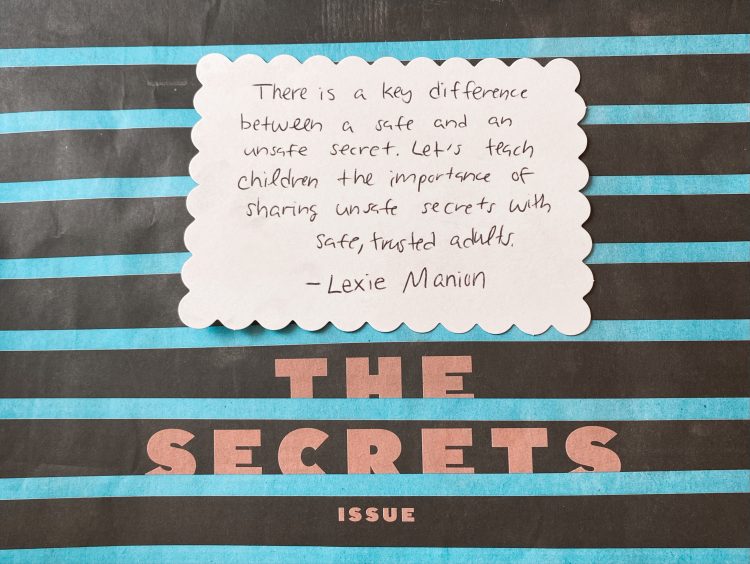The New York Times for Kids Dropped the Ball With Their New 'Secrets' Issue
Editor's Note
If you’ve experienced sexual abuse or assault, the following post could be potentially triggering. You can contact The National Sexual Assault Telephone Hotline at 1-800-656-4673.
It’s a Sunday afternoon and I’m paging through The New York Times. I come across The New York Times for Kids section, titled “The Secrets Issue” — a blacked out background with a pair of eyes peering through contrasting blue window panels.
The type across the top reads, “Editors’ Note: This section should not be read by grown-ups.” That tongue-in-cheek humor — or a true direction as to who should and should not read this section — makes me feel uneasy. Will a child assume no other adults read this or will they think this content is solely for them? Is this also creating a threshold where secrets are kept and never addressed? Will children who hold secrets of abuse get the wrong impression and continue to not speak up?

On the fourth page, in the Science section titled “I’ll Never Tell,” I am relieved to read, “In some cases, like when a secret involves someone getting hurt, you need to tell an adult who can help” when discussing how some secrets are thrilling to keep. The writer breaks secrets down into three categories: The Fun Ones, The Juicy Ones and The Guilty Ones. While this brief acknowledgement of when we must confide in a safe adult exists, this is the only direct mention of unsafe secrets in the entirety of the thirteen page issue. It is careless to not expand on this idea or even create a fourth category potentially titled, “The Unsafe One.”
The remainder of this issue details lighthearted ways to conceal a secret, hide a journal or money, how to spy and how to talk in secret code. In a piece of such popular news that is widely distributed throughout the country, The New York Times neglects to tell the other side of secrets that can cause immense harm. There is never an age too young to educate children on abuse. The details we give children may vary with each age group and we may elaborate more as they grow up, but they deserve at every age to understand the harmful effects of keeping unsafe secrets.
Having been a child who kept unsafe secrets about my trauma and now deals with the effects of complex post-traumatic stress disorder (C-PTSD) as an adult, I find it discouraging that The New York Times for Kids failed to address the difference between safe and unsafe secrets. I’d like to take a moment to further define the difference, as children deserve to understand.
A safe secret, which is widely detailed in this issue, can involve a secret we keep in order to protect someone — but in a lighthearted way. For instance, as children, we may have kept a secret from a loved one about a gift we bought them or a party we planned. There is also the type of secret that we keep in order to not hurt someone else’s feelings. As we grow up and learn boundaries and how to grow healthy relationships, we naturally learn that it may be better to not tell others (parents, friends, classmates, etc.) every single thing; it is healthy to maintain boundaries and privacy. Perhaps you’ll tell your parents or friends about your day, but leave out that you have a crush on someone new. We may feel uncomfortable to spill the beans about a lighthearted secret until we better understand it ourselves. We may keep the secret for now and then one day, let them in on it, too.
It’s important to note that not every family dynamic is the same and we may not feel safe to disclose more personal information with adults like family. Like anything in life, a healthy balance can be found.
An unsafe secret can involve someone who hurt us or someone else who was harmed. We may keep these secrets because we do not know what to do with the information or we may be scared to speak up. I remained quiet in my traumas and friends’ traumas as a teenager, because I had no idea I could get help for us. I did not know help existed. I had no education on how to handle it. This caused a delay for me and my friends to receive the appropriate help.
This is my qualm with The New York Times for Kids issue this month: I am concerned about the way they covered so much about secrets, yet failed to elaborate on what to do and how to get help if someone has hurt us or someone else. It is imperative to know there is help available. It matters that children know they do not have to keep unsafe secrets.
In addition to not providing resources for children to find safety, The New York Times also did not define unsafe secrets, besides the one brief sentence differentiating the two. The New York Times had a great opportunity to provide a section outlining that it is important for children to know the names for their biological body parts, as children deserve to know what to refer to if they were sexually abused. Recent research has found that children not feeling embarrassed of their body parts and them being able to correctly identify them anatomically helps in the fight against child sexual abuse. In Psychology Today, the American Academy of Pediatrics explains, “In early childhood, parents can teach their children the name of the genitals, just as they teach their child names of other body parts. This teaches that the genitals, while private, are not so private that you can’t talk about them.”
Perhaps if The New York Times delved into this glaringly obvious, yet sadly taboo aspect of secret-keeping in regards to recognizing sexual abuse, children would feel more empowered in their body autonomy, rather than left defenseless and uncertain.
Lastly, besides offering resources to contact such as hotlines, as not all children have access to contact a hotline, The New York Times should have made it clear who a child can reach out to if they are being harmed. Teachers, coaches, parents of friends, etc. can be instrumental in getting us the help we need. Finding a trusted adult who we feel safe with is a valuable part of getting help. Friends and other family may also be great sources of support, but a trusted adult who has the power to report abuse or neglect is exceedingly important.
My heart aches for those who may read this issue of The New York Times and may not get the full scope on secret-keeping. Their take on how secrets are captured in mostly a fun light detracts from the conversations we must be having about trauma, abuse and mental health. This issue feels rudimentary and incomplete at best. We may feel we need to exclude certain information and make everything lighthearted to make everyone feel comfortable, but children’s safety always precedes “comfort.”
Children deserve to have resources for safety. Children do not have to keep unsafe secrets. When I was a child, I felt protective of those who harmed me; I never wanted to cause harm in return. The valuable lesson I have learned is that my safety comes first. If my seeking help and safety harmed others, then so be it; I never had to remain silent in order to be a peacekeeper. I want children to learn from what I experienced and choose help over self-hushing.
It may very well be impossible to not discuss the other side of lighthearted secret-keeping in a time following the #MeToo era. It is our responsibility as writers to include resources and help when we are discussing this topic. How could we not acknowledge the importance of differentiating safe and unsafe secrets?
It matters in our autonomy and growth to keep secrets and not have to tell everyone everything. At the same time, children deserve to know when and where to get help if the secrets they are holding are unsafe.
April is National Child Abuse Prevention Month and Sexual Assault Awareness Month, so let us be the voices, the survivors and truth-tellers who encourage The New York Times to be more mindful of the complexities and detriment of secret-keeping in the future. While they missed their last opportunity to speak on this, this month is a new opportunity to potentially share survivors stories and educate children on what unsafe secrets are and how they can reach out for help.
Let us encourage children to be open and reach out when they are being harmed or know someone else is being harmed. All children deserve the space to be heard and kept safe.
Header image via The New York Times for Kids Instagram

